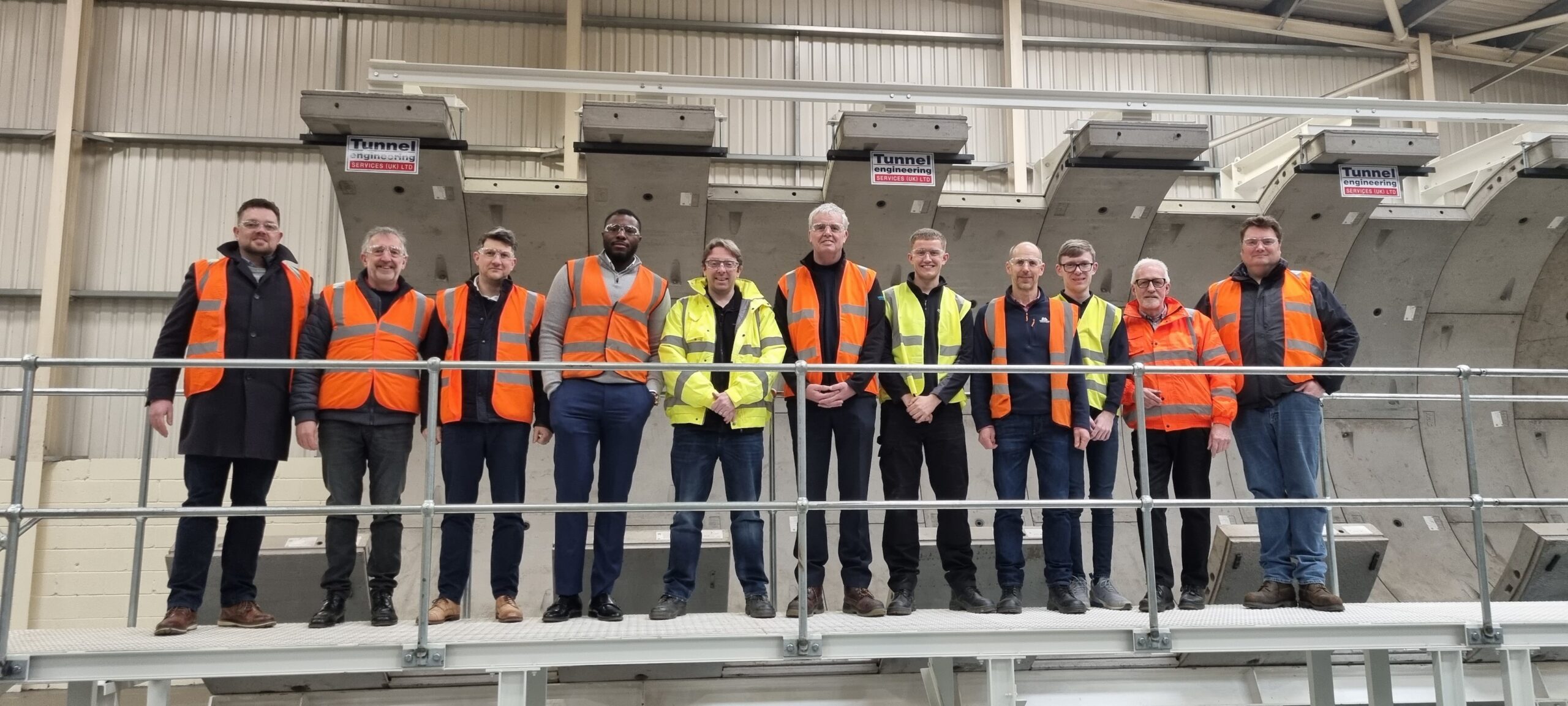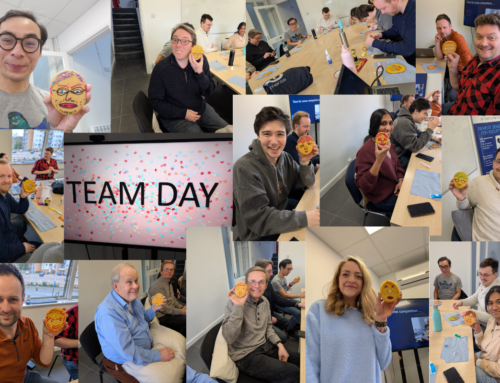
Automation has long been recognised as a faster, more cost-effective method of installing mechanical and electrical services into tunnel infrastructure. However, achieving the precision required for installations on the dynamic interface of a tunnel has proved challenging.
Boring tunnels for large transportation infrastructure are typically achieved using tunnel boring machines (TBM), which represent an automated system for cutting through the ground and installing the tunnel lining. However, fitting out tunnels for mechanical, electrical, and communication services is still a manual process involving multiple teams of workers fixing the bracketry for support cabling. This installation method is time-consuming, labour-intensive, and costly and presents significant challenges from a Health and Safety standpoint.
In March 2021, UK Research and Innovation (UKRI) launched a competition under the Industrial Strategy Challenge Fund (ISCF), inviting organisations to apply to conduct a feasibility study to design robotics and artificial intelligence (RAI) technology to deliver a robotic automated solution. This solution would facilitate installing and maintaining mechanical, electrical, and communication services within a tunnel environment.
The Feasibility Study – part-funded by ISCF and supported by Innovate UK.
Name: The application of robotics for the automated installation of tunnel mechanical, electrical and communication systems.
Project reference: 10004424
Active date: March 2021-August 2021
Technology Readiness Level (TRL): Low
The key focus was the automation of the installation process to provide industrywide improvements specifically to reduce the following:
- Construction plant movement and number of visits to the work face
- Delivery costs
- Installation costs
- Material waste
- Carbon footprint
- Operatives in the tunnel
Operating under the guidance of the project lead, Tunnel Engineering Services (TES), a consortium consisting of Costain, the Manufacturing Technology Centre (MTC), and i3D Robotics (i3D), successfully applied to conduct the feasibility study and was awarded just under £70,000 towards the projected cost of £95,500.
TES specialises in designing and manufacturing tunnelling equipment for the construction industry and has supplied tunnelling machines and equipment to many major infrastructure projects, including the United Utilities West East Link (WELM) pipeline, Stratford City Utility Installation (Olympics), National Grid London Cable Tunnels and Networking Rail Farnworth Rail Tunnel, which was the largest diameter excavator machine ever built in the UK.
The MTC is a leading research and technology organisation, part of the High-Value Manufacturing Catapult supported by Innovate UK. With world-leading facilities, it helps deliver innovation in manufacturing and technology that has the potential to transform industries. The MTC made its Fanuc robots available and supported software development to open the pathway for integrating robots and AI.
Costain is a British construction and engineering company that delivers smart and sustainable infrastructure solutions across the UK. TES’s industry knowledge and expertise in real-world tunnelling and fit-out requirements complemented Costain’s perfectly, providing an extra level of understanding of sizeable national infrastructure challenges.
Smart Award – part-funded by Innovate UK
Name: A-TRIS (Automated Tunnel Robotic Installation System)
Project reference: 10029003
Active date: May 2022 to March 2024
TRL: Mid
Having conducted a successful feasibility study, Innovate UK granted around £1,500,000 of funding to develop, build, and demonstrate a prototype solution for automated tunnel M&E installation.
The consortium, again led by TES, consisted of i3D, The MTC, Costain, and VVB Engineering, specialists in designing, delivering, and maintaining mechanical, electrical, fire, and telecommunications services for infrastructure projects. The addition of VVB provided hands-on specialist knowledge of real-world M&E installation challenges within tunnel environments, having delivered significant projects around the UK, including the Dartford Crossing, Bank Station capacity upgrade, and the Birmingham Westside Metro Extension.
ATRIS aimed to demonstrate the first AI and robotic integrated solution capable of autonomously selecting brackets, identifying the correct location for mounting along a tunnel wall, and screwing them into position. Guided by stereo vision cameras, robotics integrated with AI were required to identify the location of the holes for the brackets, select the correct fixings, and then position the fixings directly into the corresponding holes. The challenge here was training the software to recognise the precise space in which to position the screw. This was successfully demonstrated in July 2024, representing the first-ever success worldwide of this type of autonomous installation within a dynamic environment.
Small Business Research Initiative (SBRI) – First of a Kind – Funded by the Department for Transport and HS2 Ltd, managed by Innovate UK and delivered in partnership with Innovate UK KTN.
Name: DATA-IS (Digitally-Assured Tunnel Assets – Information System)
Active date: July 2024 – September 2024
TRL: Upper Mid
This SBRI First-of-a-Kind competition aimed to develop demonstrators offering innovations in Customer Experience, Reliable and Easy-to-Maintain Assets, Optimised Train Operations, and High-Speed Rail Partner Systems Installation. The consortium won the competition in the latter category and used the results to further develop the work achieved under ATRIS.
DATA-IS uses integrated stereo vision, robotics and AI to provide real-time quality and safety assurance data related to fixing brackets to a tunnel wall. It uses live data and information from services installed by ATRIS to verify and record angles, locations, and tolerances within a digital form, thereby delivering technical assurance of the successful installation of each bracket.
A key part of the brief for this competition was to demonstrate the technology’s ability to deliver cost efficiencies and increase value for money in high-speed rail system installations. Other requirements were to show:
- The technology works as designed when integrated into larger complex systems and delivers the expected outcomes
- The technology is accepted by and delivers benefits for high-speed rail and the broader rail industry
Preference was given to applications which offered innovations that multiple railway organisations could use.
In the winners’ announcement, the judges stated that the “… benefits to HS2 are clearly identified, with further efficiencies highly likely.”
Using the services installed by ATRIS, the consortium of TES, MTC and Costain, led by i3D, won the FOAK bid. The technology for DATA-IS was trialled using the ATRIS system. The exercise demonstrated not only that DATA-IS functioned as expected, but also that it is possible to integrate it into larger and more complex systems to deliver usable and valid data. Whilst the competition required the technology to be applied to the broader rail industry, DATA-IS proved that, combined with ATRIS, this fully automated tunnel installation and assurance solution can be used across various infrastructure projects, including rail, road, water, and energy.
“Technical and quality assurance is critical for the installation of mechanical and engineering services in tunnels, but conducting assurance in a tunnelling environment can be a time and labour-intensive process due to the confined space with limited entry and exit points, and with the possibility of reworks, it could take many months to execute safely.
“Real-time assurance for capital infrastructure projects can transform the efficiency across a project’s lifecycle, providing greater value-for-money and mitigating risk. Through the DATA-IS concept, this has become a reality. Working closely with our like-minded partners, we have made a real breakthrough – a system that provides technical and quality assurance at the point of installation.” Tony Mallichan, digital growth lead, road and rail, Costain
Tangible outcomes from this project include:
- Reduced health and safety risks by limiting the number of operatives at work face
- Improved delivery times owing to continuous automation
- Reduced costs through reduction of requirement for rework through real-time quality and technical assurance, better document control and proper documentation
“Being involved with this project from concept to point of deployment has been a privilege. The technologies we and the consortium partners have developed represent a sea change for the construction sector, truly a First of a Kind with the demonstrated ability to revolutionise infrastructure-building processes.” Dr Richard French, Senior Systems Scientist, i3D robotics.
The success of these projects is now being carried forward in a collaboration with Nuclear AMTC, Milne Research Ltd, KAMRI, the advanced manufacturing technology centre in South Korea, and their commercial partner, KIOT. The Korean partnership is delivering the digital twin visualisation that draws together the 3D models and integrated data to recreate the virtual environment, allowing the set-up to be checked prior to the work commencing.
Beyond rail, this system has potential applications in the nuclear and petrochemical sectors, as well as other heavy industries where precise placement of articles is required, combined with a desire to reduce headcounts at the workface.





